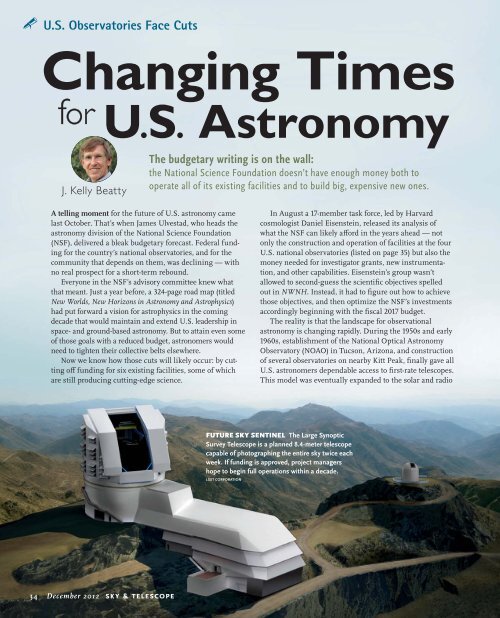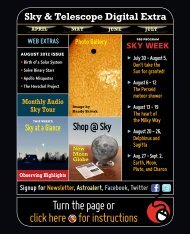Sky & Telescope Magazine December 2012 - TuLaTri.com
Sky & Telescope Magazine December 2012 - TuLaTri.com
Sky & Telescope Magazine December 2012 - TuLaTri.com
Create successful ePaper yourself
Turn your PDF publications into a flip-book with our unique Google optimized e-Paper software.
U.S. Observatories Face Cuts<br />
Changing Times<br />
for<br />
J. Kelly Beatty<br />
U.S. Astronomy<br />
The budgetary writing is on the wall:<br />
the National Science Foundation doesn’t have enough money both to<br />
operate all of its existing facilities and to build big, expensive new ones.<br />
A telling moment for the future of U.S. astronomy came<br />
last October. That’s when James Ulvestad, who heads the<br />
astronomy division of the National Science Foundation<br />
(NSF), delivered a bleak budgetary forecast. Federal funding<br />
for the country’s national observatories, and for the<br />
<strong>com</strong>munity that depends on them, was declining — with<br />
no real prospect for a short-term rebound.<br />
Everyone in the NSF’s advisory <strong>com</strong>mittee knew what<br />
that meant. Just a year before, a 324-page road map (titled<br />
New Worlds, New Horizons in Astronomy and Astrophysics)<br />
had put forward a vision for astrophysics in the <strong>com</strong>ing<br />
decade that would maintain and extend U.S. leadership in<br />
space- and ground-based astronomy. But to attain even some<br />
of those goals with a reduced budget, astronomers would<br />
need to tighten their collective belts elsewhere.<br />
Now we know how those cuts will likely occur: by cutting<br />
off funding for six existing facilities, some of which<br />
are still producing cutting-edge science.<br />
34 <strong>December</strong> <strong>2012</strong> sky & telescope<br />
In August a 17-member task force, led by Harvard<br />
cosmologist Daniel Eisenstein, released its analysis of<br />
what the NSF can likely aff ord in the years ahead — not<br />
only the construction and operation of facilities at the four<br />
U.S. national observatories (listed on page 35) but also the<br />
money needed for investigator grants, new instrumentation,<br />
and other capabilities. Eisenstein’s group wasn’t<br />
allowed to second-guess the scientifi c objectives spelled<br />
out in NWNH. Instead, it had to fi gure out how to achieve<br />
those objectives, and then optimize the NSF’s investments<br />
accordingly beginning with the fi scal 2017 budget.<br />
The reality is that the landscape for observational<br />
astronomy is changing rapidly. During the 1950s and early<br />
1960s, establishment of the National Optical Astronomy<br />
Observatory (NOAO) in Tucson, Arizona, and construction<br />
of several observatories on nearby Kitt Peak, fi nally gave all<br />
U.S. astronomers dependable access to fi rst-rate telescopes.<br />
This model was eventually expanded to the solar and radio<br />
FUTURE SKY SENTINEL The Large Synoptic<br />
Survey <strong>Telescope</strong> is a planned 8.4-meter telescope<br />
capable of photographing the entire sky twice each<br />
week. If funding is approved, project managers<br />
hope to begin full operations within a decade.<br />
LSST CORPORATION



